Valentine’s Day in pandemic Rome: A romantic hotel and tracing Spartacus’ footsteps on the Appian Way

The Appian Way is Rome’s road of blood.
The other day Marina and I walked nearly six miles of arguably Italy’s most famous road, a hike always shrouded in violent history. It was on this road that Spartacus and his 6,000 slaves were crucified (See “Spartacus: Failed Labor Revolts”) in 73 B.C. It was on this road that Ancient Rome’s generals led their armies to the Adriatic Sea to conquer foreign lands and bring back their people as slaves, the Romans’ swords dripping with blood.
Ah, yes. Nothing says “romance” like Valentine’s Day in Rome.
Rome is a city that forms the root of the word “romance” and where Valentine’s Day began. Yet the Valentine’s Day origins are deep in evil and death, persecution and martyrdom. In fact, the concept of love in Ancient Rome has all the romance of a Grade B prison film. The most powerful civilization in man’s history treated women slightly better than some of their more well-liked cattle.
Yes, Rome has changed since then. You don’t need to know a single Roman to feel the romance of this place. Just take a walk. Dimly lit piazzas. Back-lit monuments. Churches with their cupolas aglow. Dining at outdoor tables surrounded by foliage and classical music. No wonder Romans invented the term “public display of affection.” (Ancient Romans referred to it as “coitus minimus.”)
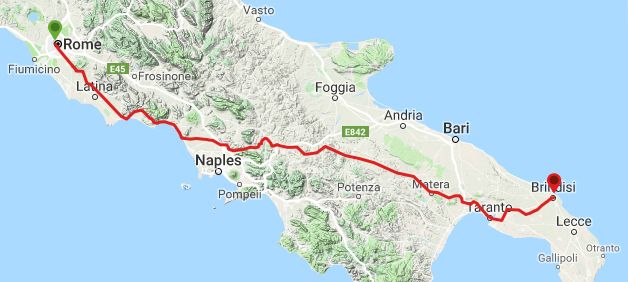
Rome is the most romantic city in the world, and Marina and I made the best of Valentine’s Day in the middle of a pandemic. All restaurants and bars still close in Italy at 6 p.m. except for takeout and delivery. No problem. Since October we’ve gone out for lunch instead of dinner.
However, Marina went out to lunch with her parents Sunday afternoon and I was busy watching my beloved A.S. Roma beat the mortal piss out of Udinese, 3-0. Instead, I booked us a room in a romantic hotel that night and arranged to have dinner ordered in. Then we’d wake the next morning, carb up at the hotel’s terrific breakfast buffet and walk the Appian Way, putting a bookend on the contradiction that is Valentine’s Day in Rome.
It wasn’t much of a road trip. We traveled all of seven miles. But after a year in Italy, where the pandemic first hit hardest and returns periodically for gut punches, it felt like a two-week honeymoon.
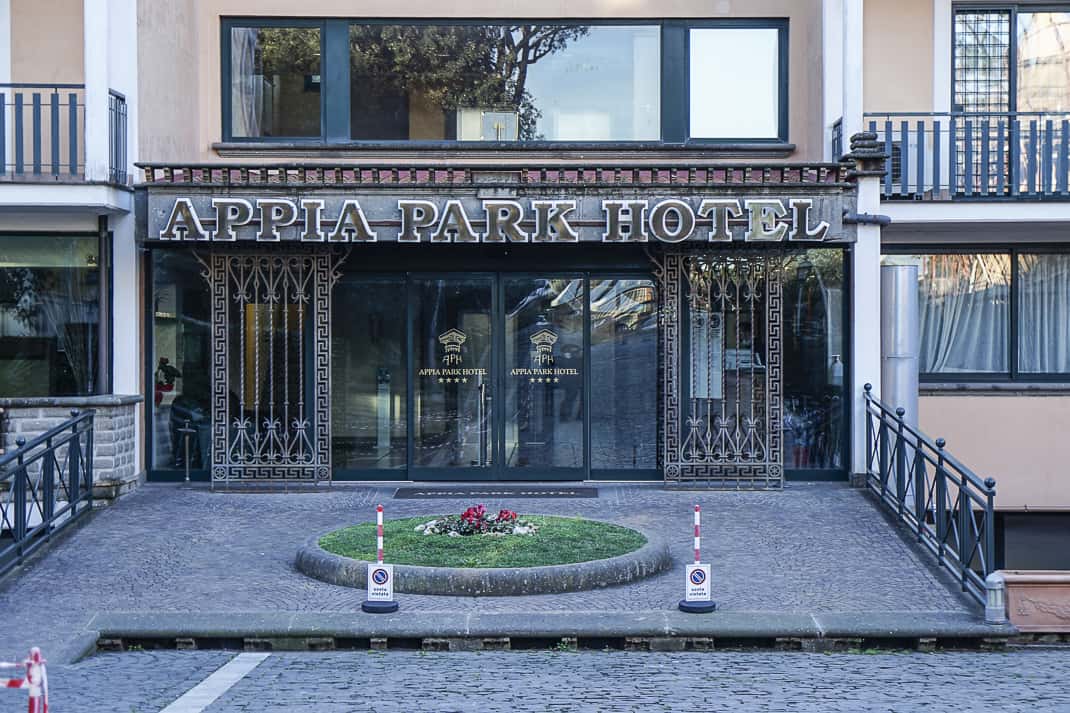
The hotel
The Appia Park is a four-star hotel on Via Appia Nuova, the modern road that parallels the Appian Way, known officially as Via Appia Antica. The hotel, built 20 years ago, is on the southeast end of Rome, about six miles from Rome’s Centro Storico where the heart of Ancient Rome pulsed and still does today.
A long, stone driveway behind an iron gate leads to a modest three-story hotel with an understated lobby. It looked empty. During this pandemic, most hotels in Rome are. Last year the pandemic cost Italy about 100 billion euros in tourism dollars. The hotel clerk said only 20 other people were checked in, all here for business.
“We’re tourists from Rome,” I said.
He smiled. During these times, we could all use a few laughs. The good news is the hotel, with few guests on a slow month in normal times, was only 80 euros.
Our Valentine’s Day was long on relaxation and short on heart-shaped rockets. After checking in, Marina snoozed. I watched soccer on Sky, a channel too expensive for my home budget. That night we took the menu the front desk provided for Ristorante San Tarcisio and ordered in.
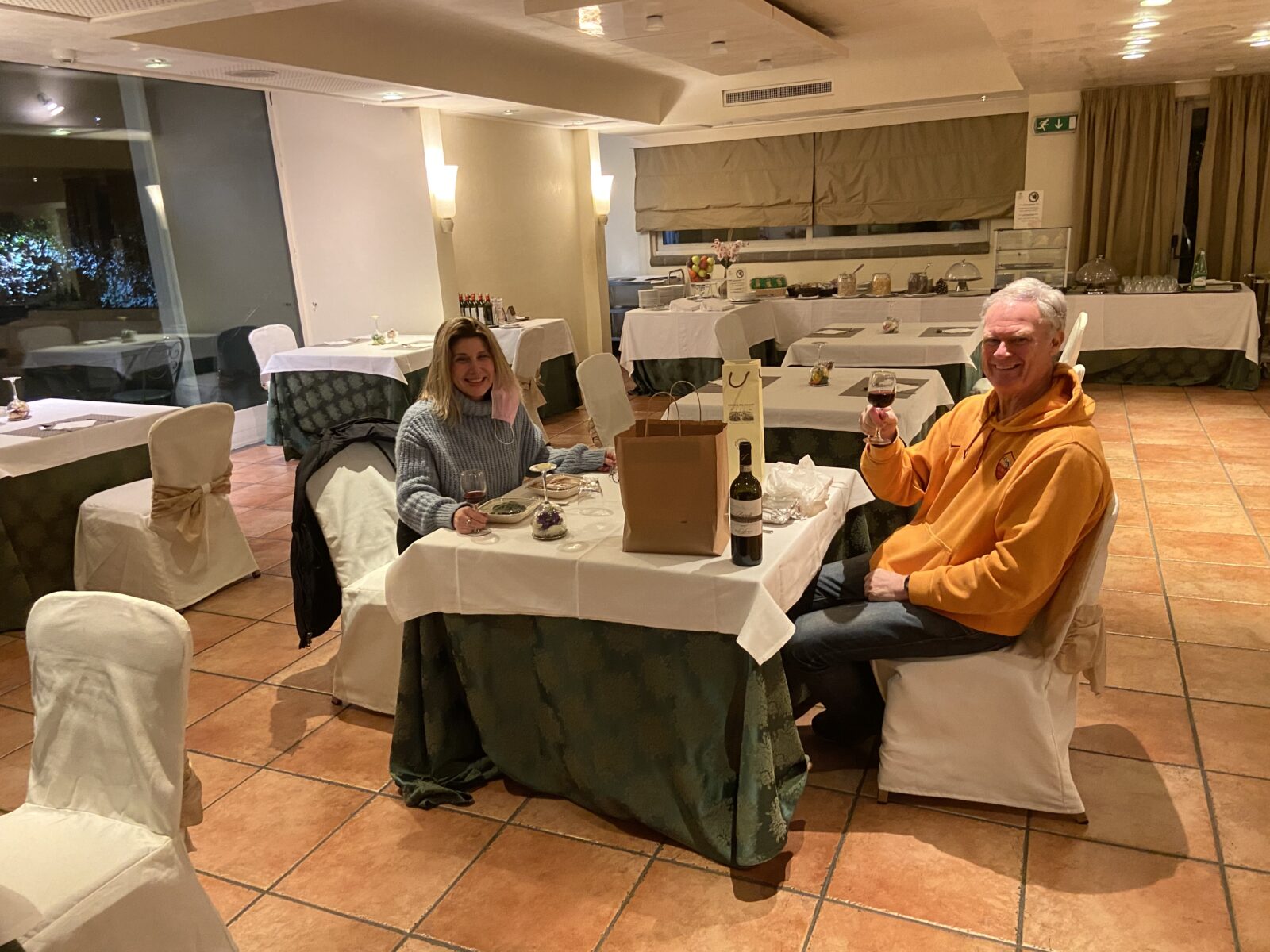
They delivered in a big, brown paper bag and we took it and a bottle of Barolo I brought from home into the hotel’s empty dining room. The restaurant tried spicing it up by providing a flower decoration enclosed in a wine glass. What our Valentine’s dinner lacked in atmosphere it made up for in flavor. After all, even during a pandemic, this is still Rome. My lasagna was spectacular, meaty yet light. Marina’s involtini alla romana (small beef and bacon rolls in tomato and wine sauce) was, she said, “Buonissimo!” With a side order of cicoria (Italy’s black, spinach-like vegetable) and a chocolate fondente dessert it was only 41 euros.
No V-Day price gouging in this town.
The history
If only St. Valentine could’ve enjoyed the day that he inspired for 1,700 years. Instead, it was the worst day of his life. It was the last day of his life, the day he was executed, or, so the story goes.
According to legend, Valentine’s Day began in the 3rd century A.D. when Christianity was slowly growing here — and often died in mass slaughters in the Colosseum. Valentine ministered Christians whom the Roman Empire persecuted. Emperor Claudius II banned marriage for his soldiers as he felt marriage made men weak. Valentine arranged secret marriages and Claudius found out, threw him in jail and picked the day of his execution.
Feb. 14.
While in jail, St. Valentine fell in love with his jailer’s daughter (or, as one story goes, cured her blindness). On the day of his execution, Feb. 14, he sent her a love letter.
He signed it, “From your Valentine.”
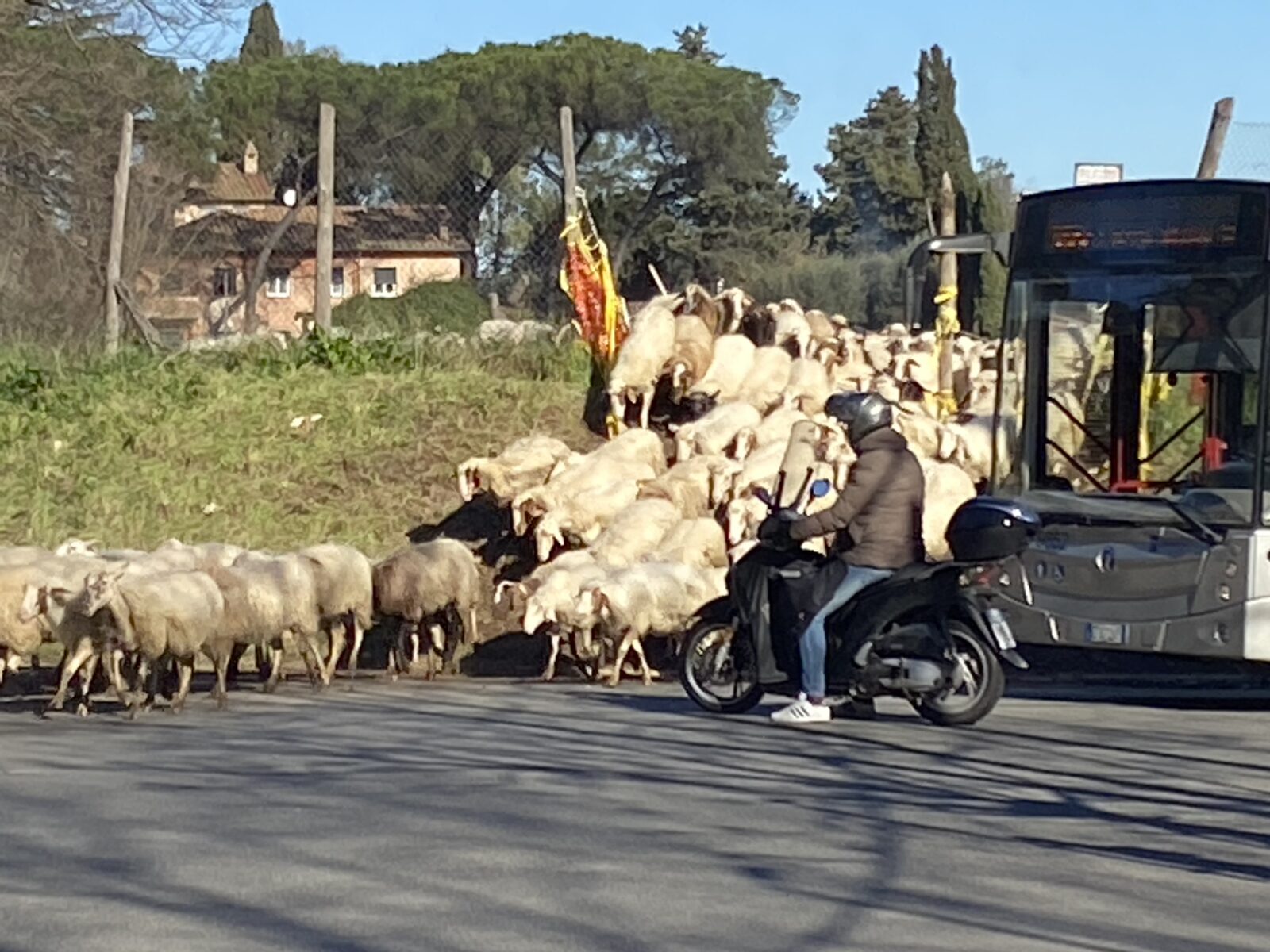
Another equally cruel story is that from Feb. 13-15, Ancient Rome celebrated the Feast of Lupercalia, a pastoral festival believed to purify the city. Men sacrificed a goat and a dog and whipped the women with the hides. The women lined up for the treatment. They actually thought it made them fertile. Scarred but fertile.
Modern Rome has developed so far since those times, and not just on Valentine’s Day. There is a romance here. While Italian men have quite the randy reputation, they do know how to romance a woman. They can turn on the charm. And they know the power of their accent, especially with American women. I have one friend who every time he went to the U.S. he practiced his accent.
By the time he landed he sounded like Rudolph Valentino hitting on Sophia Loren at the San Remo Film Festival.
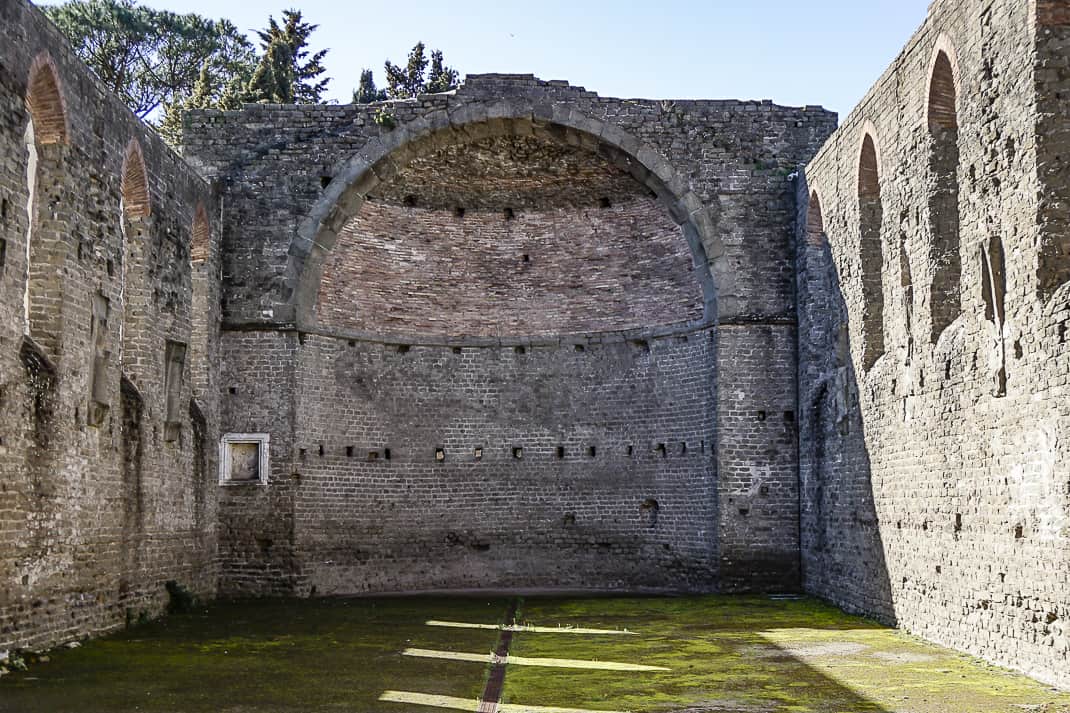
But nearly 3,000 years ago, the relationships here between men and women weren’t based on love, courtship and respect. They were based on violence, politics and money. In around 753 B.C., when Romulus and Remus were said to form the city, Romans attacked neighboring tribes. Along the way they raped the women. Giambologna’s famous 1583 statue, “The Rape of the Sabine Woman,” is one of the most viewed pieces in the Loggia della Signoria in Florence.
In the early years of the Roman Empire around the 1st century B.C., girls stopped formal education at 11 and were thrown into arranged marriages in their teens. Families made marriages for status and economic advantages.
Italian men in Ancient Rome were famous for their love poetry. However, much of the subject matter was their extramarital affairs. Women could divorce but not for another man.
Yes, women here have changed a bit. It’s 2,000 years later and Marina, a third-generation Roman, is all over my ass about directions on the road Spartacus took to his death.

The hike
Originally, the Appian Way was a 362-mile cobblestone road that started from Rome. It headed south all the way to the Tyrrhenian Sea, cut east through the region of Campania then continued southeast through Puglia until it reached the Adriatic port city of Brindisi. Today, it is paved starting near Castel Gandolfo, the pope’s former summer residence about 20 miles from Rome.
Construction on the Appian Way began in 312 B.C. during the war with the Samnites, an ancient tribe who inhabited south-central Italy, as the tepid marsh between Rome and the Tyrrhenian made it impossible to support the troops. Appius Claudius Caecus, a Roman censor for whom the road is named, began the road and built a map showing the roads that led to the far reaches of the republic’s territory. Thus began the phrase “All roads lead to Rome.”

The Romans defeated the Samnites in 304 B.C. and thus the Appian Way began hundreds of years of transporting troops to battle and supplies to support them. Then came 73 B.C. when Spartacus led a slave revolt that defeated numerous Roman armies but then found themselves trapped in a valley in Campania. General Marcus Crassus captured the rebels who were judged guilty by a Roman judge. About 6,000 of them, along with their charismatic leader who went onto Hollywood legend, were crucified over 120 miles between Rome and Capua, about 25 miles north of Naples.
The Appian Way’s construction was ingenious at the time. Building over a dirt road, Appius covered it with small stones and mortar then put over them large, interlocking stones. Observers said the stones were so smooth you couldn’t see the interlocking joints. The entire road was completed in 264 B.C.
It’s 2,285 years later, and Marina and I are walking along those same stones.
Most of the road has been reconstructed. Small cobblestones similar to what you see in the center of every Italian city cover most of the road today. However, there are stretches in Rome where the original stones, some as big as small satellite dishes, still exist. They are so hard to maneuver, the city built a narrow dirt path for cyclists to negotiate instead of racking their chassis.

An information desk gave us a handy map showing every point of interest covering six miles starting from that office. On a sunny 43-degree Monday morning, thankful we weren’t under a foot of snow like most of the U.S., we set off south.
We first entered the gates of beautiful manicured grounds. This is the home of the Catacombs of St. Callistus, the most important Christian burial site since the 3rd century A.D. Inside are 12,000 square meters of tunnels on four levels where many popes and martyrs are buried. I’ve toured it twice and we moved on, observing catacomb workers playing a pickup soccer game on a scruffy makeshift soccer field.
We passed the Basilica of Saint Sebastian, built in the 4th century but still looking regal, with its tower sticking up over the trees, from its 17th century reconstruction.
Walking the Appian Way is walking through nearly 3,000 years of Roman history. We walked along those ancient stones then came across Chiesa di San Nicholas, built in 1303 without a roof. It’s still standing with the curved windows all blown out.
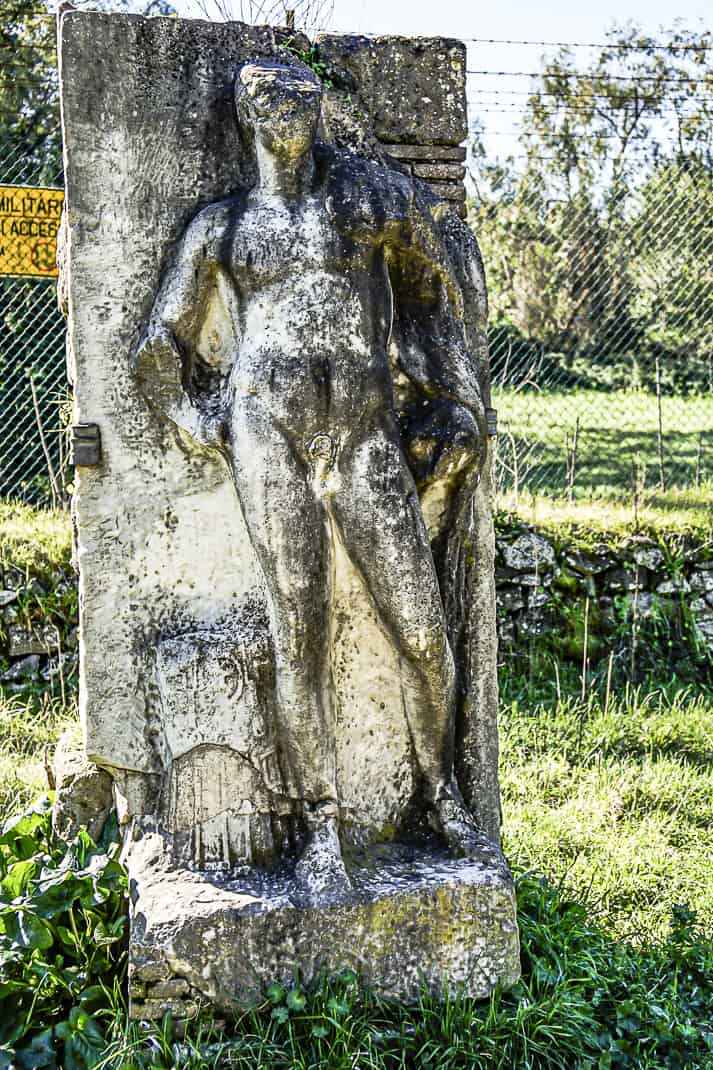
For obvious reasons, the Appian Way has always been prime real estate. Every few hundred meters we’d see a tall iron “Fuck you!” fence. We’d peer in through the slats to see a long, gravel driveway lined with manicured shrubs leading to a mansion. Gina Lollobrigida still has a villa down the road.
This would be a lovely place to live. It’s quiet with hardly any car traffic. However, you’d have to put up with hordes of walkers almost all year round. But this was a cold Monday morning in February in the middle of a deadly pandemic. Marina and I had the road nearly to ourselves, except for the occasional jogger or a local walking their dog.
The scenery was spectacular. Just six miles from the center of Rome, you feel you’re in the middle of the Italian countryside. On our short drive from the hotel, a huge flock of thousands of sheep blocked traffic as they crossed the road at a light. Not far after we passed a huge field where there are remains of a chariot stadium, we came to a clearing where we could see the Alban Hills covered in snow. Sheep grazed in the foreground. A horse walked past us. We could’ve been in rural Abruzzo but we were still in the city of Rome.
We passed so many other sites. The Tomb of Cecilia Metella, a giant round, stone building built from 30-10 B.C. built for the stepdaughter of general Marcus Crassus. The adjacent Castello dei Caetani and its palace. An ancient sculpture of a nude standing on the side of the road like a direction sign.
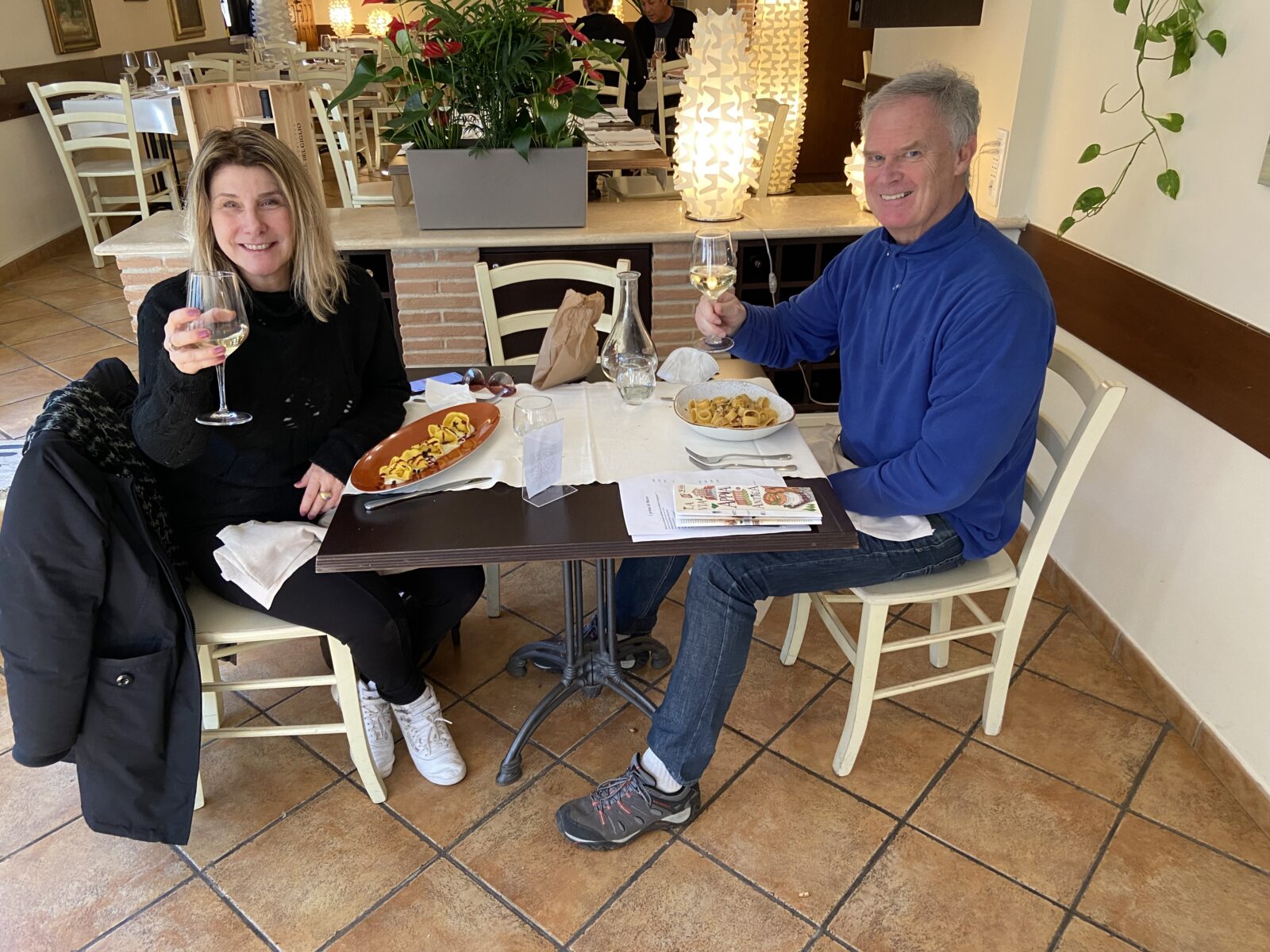
We didn’t get very far. We only walked 3 ½ miles over two hours. Too many sites to study. Too many dogs to pet. Too much nature to inhale. We stepped into modern Rome along the road for lunch at Garden Risto, a six-year-old restaurant where we sat at a table with white tablecloths next to a bust of Julius Caesar.
The menu was eclectic. I had calamarata al ragu di polpo, a thick loop pasta covered in octopus sauce. Marina had tortelloni di gorgonzola e frutti di bosco su crema di baccalà e polvere di olive, triangle-shaped, ravioli-like pasta filled with Italian blue cheese and berries covered in fish sauce and olive powder. Weird but wonderful. Marina was in heaven which is where you should spend Valentine’s Day. With glasses of Prosecco and a local Pecorino white wine, we couldn’t have asked for a better way to end a pandemic Valentine’s celebration.
I made a note to some day continue the hike to the end of the original Appian Way at the small town of Frattocchie Santa Maria delle Mole, a good 10-mile jaunt. We inquired about finding a local sheep farmer along Appian Way to write about Pecorino Romano, the wonderful, hard, salty Roman cheese that’s popular all over the world.
The Appian Way may have been built on blood and war but today it’s built on natural beauty and solitude. And isn’t that what St. Valentine would have wanted?


February 17, 2021 @ 2:38 pm
Thanks John. What a great column and way to savor Valentine’s Day in your “own backyard.” I always think I am going to spend a Sunday exploring the Appian Way. Upon returning to Rome when restrictions are lifted, it goes back on the list,
February 17, 2021 @ 8:19 pm
We lived in the country near Frattocchie and regularly hiked, ran, biked, and walked our dog on the Appia. (FYI, the old road basically disappears about Mila 9). That ancient road lined with cypress trees and umbrella pines was perhaps my favorite part of living near Roma. I found it amusing that my commute to work was on the Appia Nuova, the new road, which was built to replace the old road 1100 years ago! We also loved seeing James Bond in “Spectre” driving to a villa along the Appia at sunset (after the funeral in EUR)–a scene that reminds us how lucky we were to enjoy that golden hour every night for 4+ years.
February 18, 2021 @ 7:08 pm
Oh my gosh, what a wonderful post! History mixed with sensory experience and topped off with romance – keep ’em coming!